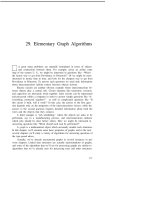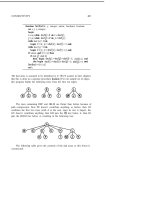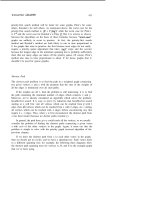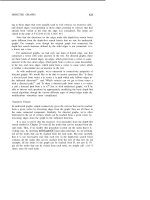Thuật toán Algorithms (Phần 36)
Bạn đang xem bản rút gọn của tài liệu. Xem và tải ngay bản đầy đủ của tài liệu tại đây (80.53 KB, 10 trang )
SEARCHING
343
adapting to the point set at hand.
Trees
Two-dimensional trees are dynamic, adaptable data structures which are very
similar to binary trees but divide up a geometric space in a manner convenient
for use in range searching and other problems. The idea is to build binary
search trees with points in the nodes, using the y and x coordinates of the
points as keys in a strictly alternating sequence.
The same algorithm is used for inserting points into 2D trees as for normal
binary search trees, except at the root we use the y coordinate (if the point
to be inserted has a smaller y coordinate than the point at the root, go left;
otherwise go right), then at the next level we use the coordinate, then at
the next level the y coordinate, etc.,
alternating until an external node is
encountered. For example, the following 2D tree is built for our sample set of
points:
The particular coordinate used is given at each node along with the point
name: nodes for which the y coordinate is used are drawn vertically, and
those for which the x coordinates is used are drawn horizontally.
344
CHAPTER 26
This technique corresponds to dividing up the plane in a simple way: all
the points below the point at the root go in the left all those above in
the right then all the points above the point at the root and to the left
of the point in the right go in the left of the right of
the root, etc. Every external node of the tree corresponds to some rectangle in
the plane. The diagram below shows the division of the plane corresponding
to the above tree. Each numbered region corresponds to an external node in
the tree; each point lies on a horizontal or vertical line segment which defines
the division made in the tree at that point.
For example, if a new point was to be inserted into the tree from region 9 in
the diagram above, we would move left at the root, since all such points are
below A, then right at B, since all such points are to the right of B, then right
at J, since all such points are above J. Insertion of a point in region 9 would
correspond to drawing a vertical line through it in the diagram.
The code for the construction of 2D trees is a straightforward modification
of standard binary tree search to switch between x and y coordinates at each
level:
RANGE SEARCHING
345
function twoDinsert(p: point; t: link) : link;
var link;
d, td: boolean;
begin
repeat
if d then
else
td :=p.y<
if td then else
d:= not d;
until
new(t);
if then else
twoDinsert:=t
end
As usual, we use a header node head with an artificial point which is
“less” than all the other points so that the tree hangs off the right link of
head, and an artificial node z is used to represent all the external nodes. The
call head) will insert a new node containing into the tree. A
boolean variable d is toggled on the way down the tree to effect the alternating
tests on x and coordinates. Otherwise the procedure is identical to the
standard procedure from Chapter 14. In fact, it turns out that for randomly
distributed points, 2D trees have all the same performance characteristics of
binary search trees. For example, the average time to build such a tree is
proportional to N log but there is an worst case.
To do range searching using 2D trees, we test the point at each node
against the range along the dimension that is used to divide the plane of that
node. For our example, we begin by going right at the root and right at node
E, since our search rectangle is entirely above A and to the right of E. Then,
at node F, we must go down both subtrees, since F falls in the x range defined
by the rectangle (note carefully that this is not the same as F falling within
the rectangle). Then the left of P and K are checked, corresponding
to checking areas 12 and 14 of the plane, which overlap the search rectangle.
This process is easily implemented with a straightforward generalization of
the range procedure that we examined at the beginning of this chapter:
346
CHAPTER 26
procedure link; rectangle; d: boolean);
var t2, tx2, boolean ;
begin
if then
begin
if then begin := txl tx2 end
else begin end;
if then not d);
if then write(name(
if then not d);
end
end
This procedure goes down both only when the dividing line cuts the
rectangle, which should happen infrequently for relatively small rectangles.
Although the method hasn’t been fully analyzed, its running time seems sure
to be proportional to + log N to retrieve points from reasonable ranges in
a region containing N points, which makes it very competitive with the grid
method.
Multidimensional Range Searching
Both the grid method and 2D trees generalize directly to more than two dimen-
sions: simple, straightforward extensions to the above algorithms immediately
yield range-searching methods which work for more than two dimensions.
However, the nature of multidimensional space dictates that some caution is
called for and that the performance characteristics of the algorithms might
be difficult to predict for a particular application.
To implement the grid method for k-dimensional searching, we simply
make grid a k-dimensional array and use one index per dimension. The main
problem is to pick a reasonable value for size. This problem becomes quite
obvious when large k is considered: what type of grid should we use for
dimensional search? The problem is that even if we use only three divisions
per dimension, we need grid squares, most of which will be empty, for
reasonable values of N.
The generalization from 2D to trees is also straightforward: simply
cycle through the dimensions (as we did for two dimensions by alternating
between x and y) while going down the tree. As before, in a random situation,
the resulting trees have the same characteristics as binary search trees. Also
as before, there is a natural correspondence between the trees and a simple
RANGE SEARCHING
347
geometric process. In three dimensions, branching at each node corresponds
to cutting the three-dimensional region of interest with a plane; in general we
cut the k-dimensional region of interest with a (k- 1)-dimensional hyperplane.
If k is very large, there is likely to be a significant amount of imbalance
in the trees, again because practical point sets can’t be large enough to
take notice of randomness over a large number of dimensions. Typically, all
points in a will have the same value across several dimensions, which
leads to several one-way branches in the trees. One way to help alleviate this
problem is, rather than simply cycle through the dimensions, always to use the
dimension that will divide up the point set in the best way. This technique
can also be applied to 2D trees. It requires that extra information (which
dimension should be discriminated upon) be stored in each node, but it does
relieve imbalance, especially in high-dimensional trees.
In summary, though it is easy to see how to to generalize the programs for
range searching that we have developed to handle multidimensional problems,
such a step should not be taken lightly for a large application. Large databases
with many attributes per record can be quite complicated objects indeed, and
it is often necessary to have a good understanding of the characteristics of
the database in order to develop an efficient range-searching method for a
particular application. This is a quite important problem which is still being
studied.









